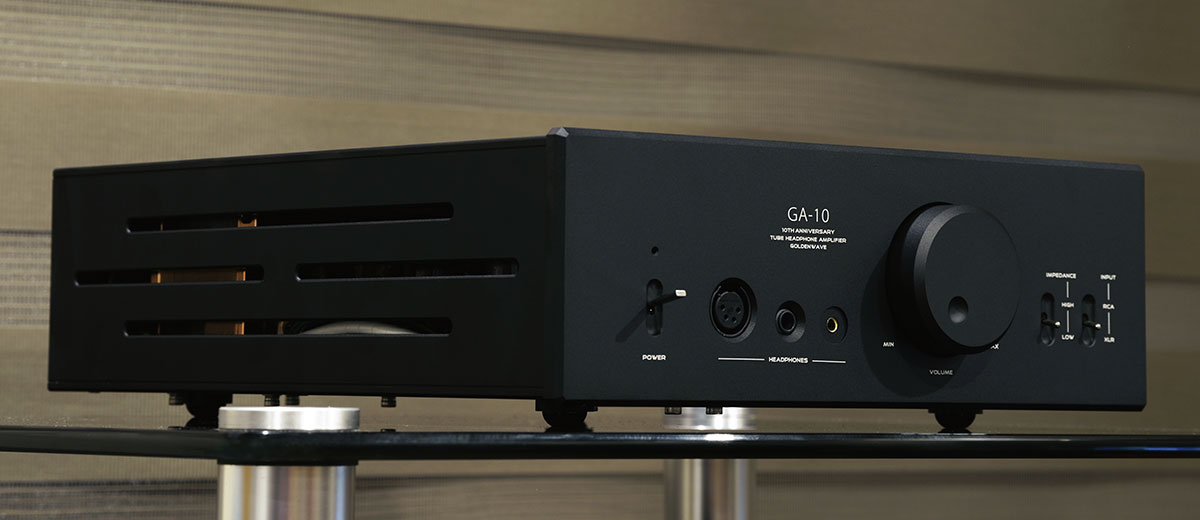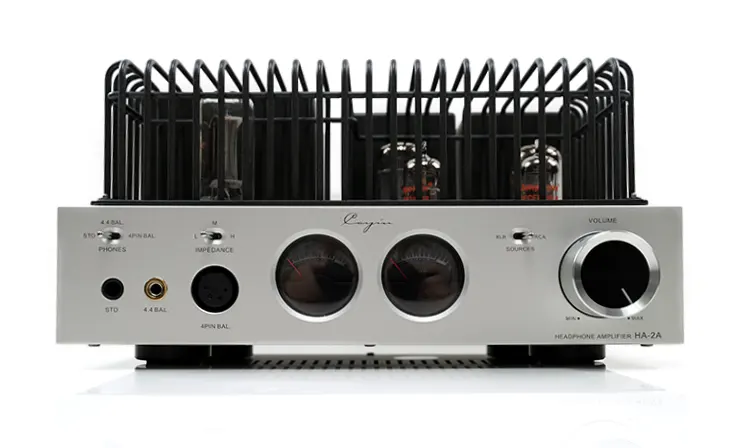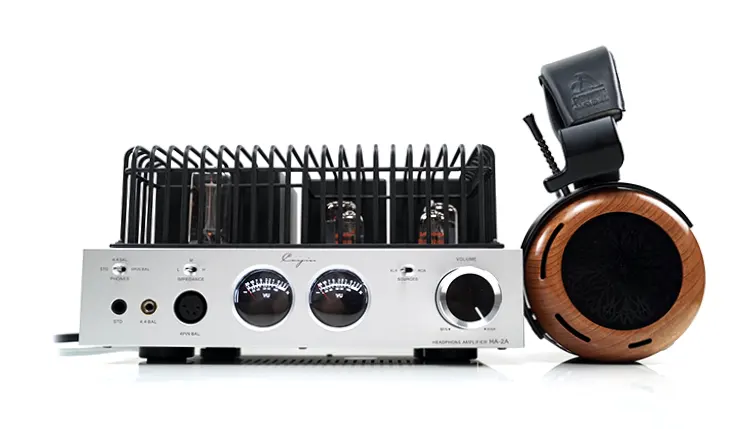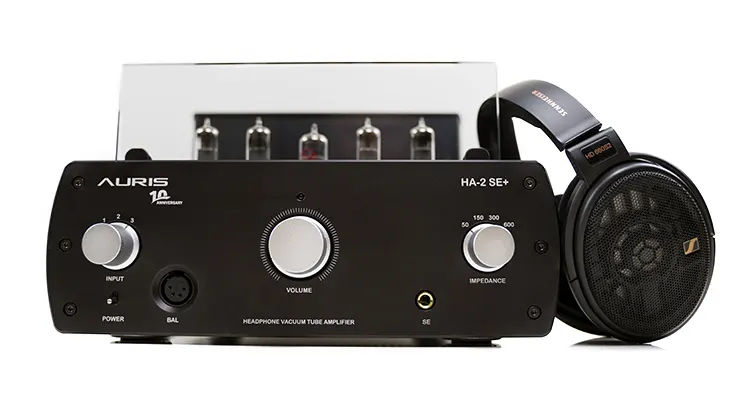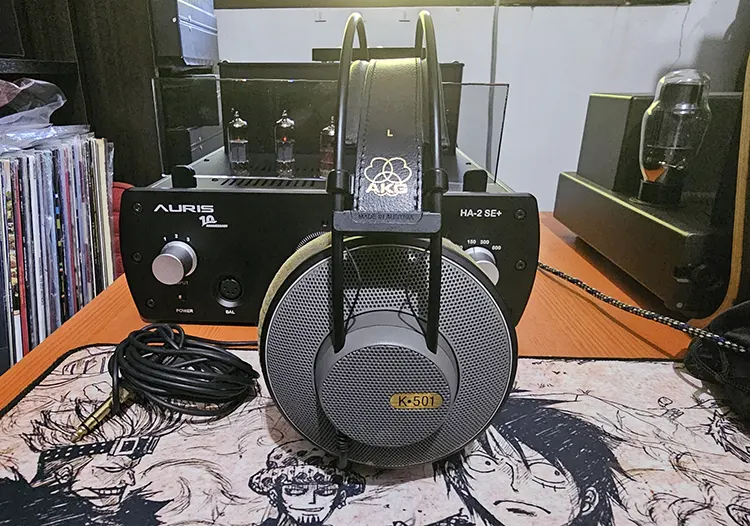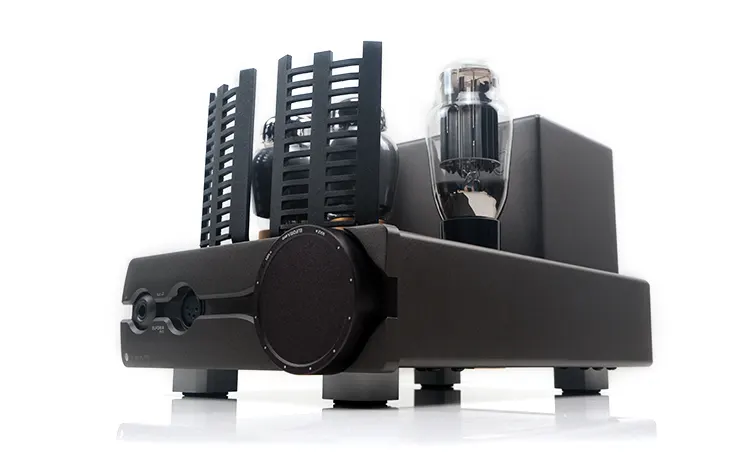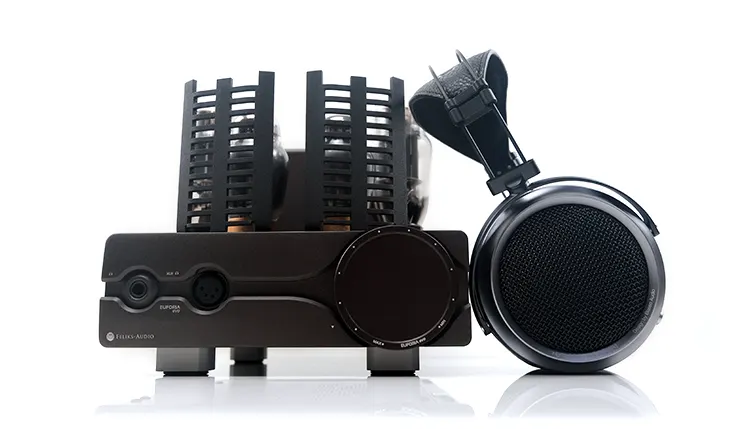Selected Comparisons
The following comparisons to the HIFIMAN Goldenwave GA-10 were completed using a mix of the HIFIMAN Serenade and Ferrum’s WANDLA GSE for my primary sources.
My selected headphone pairings included the HIFIMAN Arya Stealth Magnet Edition and the ZMF Headphones Atrium Open.
Cayin HA-2A
The Cayin HA-2A was launched at the start of 2024, with our review published shortly after. The HA-2A forms part of the company’s wider desktop i8 Series, which also includes the iHA-8, iDAC-8, and the iDAP-8.
Technical
Like the GA-10, the HA-2A is primarily a single-ended tube headphone amplifier with impedance and multiple input controls. However, that’s about it in terms of similarities.
The HA-2A is an Ultralinear quad-tube amp consisting of a composite hybrid pentode/triode Amperex ECF82 (6U8 NOS) for the driver, a matched pair of Amperex 17BF11 NOS tubes for the output, and an RCA 17AX4GT NOS tube for the rectifier.
Both have a single-ended topology. The GA-10 uses SEPP or single-ended push-pull, whereas the HA-2A is balanced-driven through Cayin’s in-house designed output transformer, but technically a point-to-point welded Class A transformer-coupled single-ended design. Neither has pre-out nor pre-amping capability.
Both amplifiers have impedance selectors, with Cayin offering 3 values as opposed to the GA-10’s two and outlining the values in more detail with low up to 64Ω, to medium (65Ω to 250Ω), and high (251Ω to 600Ω).
Both amplifiers’ peak output power has a voltage-bias, so the higher the impedance, the more power it will deliver. On raw numbers, the GA-10 has more headroom at 300Ω with up to 3W of output power compared to the HA-2A’s 1W maximum.
Just to note, the 4.4mm output of the HA-2A is significantly lowered to reduce the noise floor for more sensitive headphones and balanced IEM users at a maximum of 270 mW. This is not the case with the GA-10 with its 600 mW benchmark at 32Ω, but I would presume there is less power for lower loads than 32Ω.
Design
The HA-2A is the more compact of the two amplifiers and a likelier desktop unit choice, whereas the GA-10 is almost double the size, at least on the base, and needs a dedicated space on a rack or bench.
Surprisingly, the weight difference is not huge, with the HA-2A weighing 10kg and the GA-10 weighing 12kg. That can be attributed to their sizeable transformers.
One thing to note is the weight bias, which is off-center on the HA-2A due to those transformers, so be careful lifting it as all the weight is to the rear and not as evenly spread as the GA-10.
The aesthetics are different. The GA-10 is modern minimalist in all black with the tubes inside the main house and plenty of venting on those panels.
The HA-2A uses Cayin’s classic design “retro” language, which is a mix of modern and old school. It has top-plate mount tubes and rail guards (EU only) and illuminated VU meters.
If you want people to notice a tube amp, the HA-2A is going to fit the bill better, but if you are looking for more discreet locations to place an amp, the GA-10’s more uniform dimensions might prove more useful.
The HA-2A is the busier-looking of the two on the front panel with those VU meters, but otherwise, both amps have almost the same I/O. Both amps have a 4-pin XLR/4.4mm/6.35mm PO connectivity with volume control and input selection.
The only real difference is the PO switch above the HA-2A connection ports, something which the GA-10 does not offer. The rear panel on both is the same, with provision for XLR and RAC line input.
Performance
I tested three headphones between these two amplifiers: the 300Ω Atrium, the Arya Stealth, and the low impedance, easy-to-drive Austrian Audio Composer.
I came to the same conclusion for all three headphones regarding the core sound signature emanating from each amplifier. However, my preferred pairings depended on what I was listening to and the headphones’ sound signature.
The HA-20A is denser sounding, with a more fulsome low-end, enhanced bass bloom, and a weightier fundamental frequency. Vocal notes are more heavily textured and sit further forward than the GA-10 equivalent imaging experience. Of the two amplifiers, I find the Cayin slightly darker-sounding.
The GA-10 has more control throughout. It sounds sweeter, perhaps a little more neutral with less bloom on the lows, but a tighter mid-bass punch and more definition. The soundstage is much more open and spacious, with a stronger perception of staging width and stereo separation.
Arguably, it has a little more treble presence but not hugely so. The attention to detail and improved separation will give it a stronger perception of improved layering across the board, but at the cost of a little immediacy in vocal and bass impact.
Of the two, I find the GA-10 the purer, sweeter, and better-behaved tube amplifier sound signature. This is the one I would pair with the Atrium (or the HD 800) over all the others to take advantage of its larger staging properties, though you will still notice that enhanced width with the Arya and Composer.
I would pick the Cayin if I wanted to thicken the sound, add more bass weight and warmth to a sterile sound signature. It’s a narrower sound, but one with excellent vocal presence, so it appeals to me more for the emotional engagement.
Auris Audio HA-2SE+
The HA-2SE+ is a 3rd gen version of the original HA-2SE headphone tube amplifier from 2017. It was launched in 2023 with a price tag of $2399, but the street price today can be as low as $1299.
Technical
As with the GA-10, the HA-2SE+ is a single-ended headphone tube amplifier. However, unlike the GA-10, it also offers pre-amping capability, so its application can be beyond pure headphone use.
In contrast to the ECC83 and EL84 tube GA-10 SEPP topology, the HA-2SE+ uses a Class A SET design with a set of 4 top-loaded 7-pin EI EL95 or PL95 pentode power NOS tube configuration and a single ECC81 input tube.
Since the HA-2SE can take either EL or PL power tube variants, Auris has also provided a selector switch on the rear panel that will allow you to match your corresponding tube choices.
Both amps have impedance selector switches; however, the HA-2SE+ is documented as offering a consistent power output at all impedance levels and has 4 levels compared to the GA-10’s 2. Each level has a specific impedance parameter, such as 64 up to 600Ω, whereas the GA-10 only has high and low.
Despite the consistent output level, the HA-2SE+ headroom is much lower at 1W compared to up to 3W for 300Ω headphones for the GA-10. T
The GA-10’s 600 mW 32Ω is less suited for current-hungry headphones, perhaps less so than the HA-2SE+. However, if you have a 300Ω dynamic driver or something like the 200Ω Audeze LCD-4, then the GA-10 will deliver more power.
Design
Although the GA-10 and the HA-2SE+ have that same black aluminum panel vibe, I have to say the GA-10 is the sleeker proposition.
The HA-2SE+ marked the end of the wood-paneled versions of this amplifier range, which I know was a source of debate for some time. Beauty is in the eye of the beholder, so it is entirely personal preference, and mine was the original wood version.
Because of that design change, the HA-2SE+ aesthetic looks a little gaudy when placed beside the low-profile and smoother finish of the GA-10. Granted, the HA-2SE+ fulfills some traditional demands with a top-plate tube design, and it does indeed provide a nice glow.
However, these are small tubes, with the massive transformers dominating the form factor to the point where possibly Auris would have been better, similarly internalizing everything like the GA-10.
The HA-2SE+ design does have benefits. Its labeling on the front is much clearer, the dials are very accessible, and it does come with a durable metal remote control. It does lack a 4.4mm PO output, though, with just XLR and 6.35mm options on the front plate.
The rear plate is a very different story with the Auris having more inputs and outputs than the GA-10.
You get 2 dual RCA inputs and a single 3-pin XLR, as well as a SE dual RCA pre-out and that tube selector switch. You can also select your power requirements with a dial near the power plug to set it up for your region’s AC.
Performance
Going with the same Atrium and the Arya Stealth combo for this comparison, I found the HA-2SE+ to be the more energetic, upfront, and thicker-sounding of the two tube amplifiers.
The GA-10 was more nuanced in detail, with an airy, more spacious soundstage, comparatively even-handed in weight, with a little more sweetness and sparkle in its presentation.
Each presentation had its moments, and your ear will gravitate to one or the other depending on what part of the recording you want emphasized or the particular headphone pairing.
Of no doubt, the Atrium needs the GA-10. It sounds far more ‘bunched-up’ and decidedly soft with too much upper-bass bloom and mid-bass punch bias with the HA-2SE+.
The amp’s more mid-centric bias and narrower staging properties do not suit the Atrium as much as the more open and wider sound of the GA-10. The HIFIMAN tuning has better separation and headroom and a little less bloom, which creates a more 3-dimensional soundstage that benefits the Atrium.
I could go either way with the Arya Stealth depending on what I was listening to. The HA-2SE+ can sound a little too strident in the upper-mids and lower treble if there is a lot of emphasis in recordings, but it makes up for it with a thicker set of lows and weightier vocal notes.
The GA-10 sounds more coherent throughout, but just a little leaner sounding in the highs. It sounds smoother and more open, but sometimes percussion can lack a little weight, opting instead for delicacy over impact.
Overall, the GA-10 presents a more coherent, relaxing, and spacious performance, whereas the HA-2SE+ is more intimate, more impactful, and punchier sounding.
Feliks Audio EUFORIA evo
The EUFORIA evo was launched in 2023 and is a second —or third-generation design (if you could call it the Anniversary Edition), stretching back to the original EUFORIA amplifier from 2017.
Technical
The EUFORIA evo is also a single-ended, but unlike the GA-10’s SEPP topology and pure headphone focus, the evo is a pure OTL or output-transformerless headphone tube amplifier with pre-amp and crossfeed capability.
Some would consider an OTL design as a more pure way of delivering a tube amplifier’s performance, with the lack of a transformer stage seen as potentially limiting the potential resolution, dynamics, and bass response of the amplifier.
That said, both amplifiers are optimized for high loads, so high-impedance headphones are an attractive pairing for the GA-10 and the EUFORIA evo.
The EUFORIA evo uses PSVANE for the driver tubes, but these CV181 MK2 “Gold” tubes, which are more expensive than the GA-10 ECC83 and EL84 combo, hence the higher price of the Feliks amp.
The EUFORIA evo 6N13S (NOS) or 6H13C are black-plated Svetlana “Winged C” branded power tubes and fairly popular picks for OTL amplifiers.
On paper, the GA-10 has far more headroom at 3W into 300Ω compared to EUFORIA evo’s 280mW output power (with 20 dB of gain) into a 300Ω.
Whilst both are weaker for current demanding low impedance headphones, the EUFORIA evo is noticeably less capable, so if you want more of an all-rounder, then the GA-10 is the better pick.
However, since the majority of high-impedance dynamic driver headphones’ maximum handling power is under 280 mW, that is generally where the evo excels.
Design
The EUFORIA Evo is smaller and lighter, and aside from its tall top-plate design, courtesy of those CV181 MK2 “Gold” tubes, it can fit into tighter spaces than the GA-10.
However, the evo can emit a lot of heat, more so than the shielded GA-10, so I would not put it into spaces where it cannot breathe.
Aesthetically, both are beautiful but different-looking. The cedar brown sandblasted aluminum panel finish is a nice subtle contrast to the more masculine all-black of the GA-10 visuals.
There is more of a noire retro vibe with the more traditional top plate and large dial design of the evo, with the GA-10 straying more into Violectric modern minimal territory to my eye.
The front panel of the GA-10 looks better equipped for the modern audiophile user with options for XLR, 6.35mm, and 4.4mm, the last option of which the evo has left out.
Both have fairly low resistance volume dials, but the evo version is slightly recessed into the chassis, which helps prevent unintended bumps that could give you accidental high-volume blasts.
There is no impedance switching or input controls on the EUFORIA evo. It’s a pure OTL amplifier, which means you have to know you want this before buying. The GA-10’s high/low impedance switch gives you more room for a wider range of headphone pairings.
The rear panel is where the EUFORIA evo has some advantages with its unique crossfeed switch aimed at those with classic monaural recordings, though with my music collection, I have never found much use for it.
Though it lacks the GA-10’s 3-pin XLR line input option with just one dual RCA input, the evo does offer the pre-amp output, which I have found useful when I want to add some flavor to some power amps.
Performance
The EUFORIA evo is an incredible sounding OTL amplifier, but tonally, it is the polar opposite of the GA-10.
This is a creamier, almost lush-sounding amplifier with excellent sub-bass weight, staging depth, and rich vocal notes. It is also a darker sounding amplifier, though do not confuse that with being congested or lacking in headroom. With 300Ω headphones, it can sound beautiful.
The GA-10 takes you in a very different direction. It’s a sweet-sounding, sparkling presentation with a wider presentation, one with a little more upper harmonic presence, and a slightly more neutral note weight.
Between the two, the GA-10 delivers a slightly punchier, faster bass response with the Atrium open, but does not have the fulsome deep sub-bass response of the Euforia evo.
It excels on the X-Axis, pushing out wider, whereas the evo focuses more on the central imaging experience from the bass up to the vocal presence.
That being said, the vocal bloom from the GA-10 has a bit more dynamism to it, perhaps in part due to the darker, heavier tone of the evo. There is also a little more contrast and sparkle from the GA-10 highs that give percussion some additional sheen and presence.
The stronger decay effects from the evo tuning might also give it the perception of a more languid-sounding pairing. The GA-10 decay is a little more controlled, creating more space for the lower mids of the Atrium to be heard clearly.
The weak spot of the EUFORIA evo is planar, more so than the GA-10. Headphones such as the Audeze LCD-5, rated at a lower 14Ω impedance rating with an SPL of 90 dB, struggle more to avoid distortion on the Feliks amp than the GA-10.
My Verdict
The HIFIMAN Goldenwave GA-10 is a beast of a headphone amplifier on the outside with an almost sweet-sounding, yet beautifully defined, holographic sound signature inside.
Its output power bias favors high impedance headphones, though some planars, such as the Arya range and even a fair few IEMs, do much better than I expected with this amplifier.
It’s not an amplifier for Susvara owners; very demanding, low impedance planars are not its forte. Consider the GA-10 as an amplifier more in keeping with traditional OTL pairings, where voltage is king.
On that basis, it’s a great value tube amplifier, built like a tank, easy to use, and easy on the ear with a spacious presentation that works exceedingly well with a wide range of headphones and IEMs.
HIFIMAN Goldenwave GA-10 Technical Specifications
- Frequency Response: 20- 24 kHz, ±0.5 dB@1kHz
- THD+N: 0.001%@1kHz/300Ω
- Power Output: 3000 mW/300Ω; 600mW/32Ω, @1kHz
- Total Power Consumption: 70W
- Dimension (L*H*W): 330*110*380mm, protrusions not included

